Edimax Global website
America
Europe
Middle East & Africa
Asia Pacific

24-Port Gigabit Ethernet Management Switch with 2 SFP Slots
ES-5260GM
- 2 dual-media ports for flexible fiber connections
- Supports 802.1x port-based network access control
- IEEE 802.1D compatible, 802.1w rapid spanning tree, and IEEE 802.3ad link aggregation
- 802.1q tag-based VLAN and Q-in-Q double tag
- IGMP snooping, IGMP fast leave, IGMP filtering, and advanced MVR
- Supports DHCP snooping and relay agent with option 82
- Port-IP binding function for LAN security
- QCL based on application traffic for QoS and rate limitation management
- Supports SNMPv1 and SNMPv2c network management
Product Description
The ES-5260GM 24-Port Gigabit Ethernet Management Switch is a standard switch that meets all gigabit and Fast Ethernet specifications. This switch has 22 gigabit TP and 2 gigabit TP/SFP fiber dual-media ports, enabling it to be managed through an RS-232 serial port or an Ethernet port using CLI or a web-based management interface associated with an SNMP agent. With the SNMP agent, the network administrator can access the switch to monitor, configure, and control each port’s activity for enhanced network management and improved network efficiency. In addition, this switch features a comprehensive range of functions such as Quality of Service, Spanning Tree Protocol, VLAN, port trunking, bandwidth control, port security, SNMP/RMON, and IGMP snooping. The ES-5260GM is suitable for both metro-LAN and office applications.
Edimax’s QoS with 4 Priority Queues
The QoS Control List (QCL) feature provides 4 internal queues to support 4 different classifications of traffic. High priority packet streams will experience less delay inside the switch, which provides a lower latency level for certain delay-sensitive traffic. The ES-5260GM is able to assign different priorities to data packets according to port, 802.1p priority tag, DiffServ and/or IP TOS, IPv4, and UDP/TCP application traffic. The QoS operates at full wire speed, and the actual scheduling at each egress port can be based upon a strict weighted round robin.
Port Mirroring
The port mirroring feature allows the ingress traffic to execute port copying. This mechanism helps track network errors or abnormal packet transmission without interrupting the flow of data, allowing ingress traffic to be monitored by a single port that is defined as a mirror capture port. The mirror capture port can be any 10/100/1000 port. Mirroring multiple ports is possible, but can create congestion at the mirror capture port.
PorQ-in-Q VLAN for Improved Performance & Security
The VLAN feature in the switch offers the benefit of improved security and performance. VLAN is used to isolate traffic between different users, thus providing better security. Limiting the broadcast traffic within the same VLAN broadcast domain also enhances performance. Q-in-Q, the use of double VLAN tags, is an efficient method to enable subscriber aggregation.
Isolated Group for Port Protection
The isolated group feature allows certain ports to be designated as protected ports. All other ports are non-isolated. Traffic between isolated group members are blocked. Traffic can only be sent from the isolated group to the non-isolated group.
802.3ad LACP with Dynamic Link Fail-Over
Dynamic fail-over means packets will not be assigned to any trunk member port that has failed. If one of the ports were to fail, traffic will automatically be distributed to the remaining active ports.
802.1x Port-Based Network Access Control for Improved Network Security
The 802.1x feature enables user authentication for every network access attempt. The port security feature allows users to limit network access to non-registered users. By enabling these features, users can establish an access mechanism based on user and machine identities, as well as control the number of access stations.
802.1d Compatible & 802.1w Rapid Spanning Tree
For environments with multiple switches supporting STP, users can configure the switches with a backup bridge path, so transmission and reception of packets can be guaranteed in the event of a switch fail-over.
2 Dual-Media Ports for Flexible Fiber Connections
2 dual-media ports are available for flexible fiber connections. Users can install transceiver modules in these slots for short, medium, or long distance fiber backbone attachment. The RJ-45 module will then be disabled in the corresponding 10/100/1000Base-T connections.
Broadcast/Multicast/Unknown-Unicast Storm Control
To prevent broadcast, multicast, or unknown-unicast flooding in the network, the storm control function can be used to restrict excess traffic. Threshold values are available to control the limit rate for each port. Packets will be discarded if the count exceeds the designated upper threshold.
Access Control List (ACL)
The ACLs are divided into different EtherTypes: IPv4, ARP protocol, MAC, VLAN, etc. As you create an ACL for ingress classification, you can assign a policy for each port. Each policy can be applied to any port. This makes it very easy to determine what type of ACL policy you will be working with.
Network Interface
|
WAN
|
SECURITY
|
OUTPUT POWER
|
| 10/100/1000Mbps TP Jack (RJ-45) | TP (RJ-45) | 1 to 22 |
|
100/1000Mbps SFP Fiber Module |
TP (RJ-45) / SFP |
23 to 24 |
Hardware Specifications
| Feature | Description |
|
Voltage |
100~240V |
|
Frequency |
50~60Hz |
| Consumption | 35W |
|
Ambient Temperature |
0° to 50°C |
| Humidity |
5% to 90% |
|
Dimensions |
240 (W) x 44 (H) x 200 (D) mm |
|
Weight |
Principal: 1.64Kg |
|
Safety |
Complies with FCC Part 15 Class A & CE Mark approval |
Packing information
| Carton Dimensions (mm | Pcs / Carton | N.W (KG | G.W (KG) |
|
420 (W) x 370 (D) x 300 (H) |
5 |
12.5 |
14.5 |
*Actual viewing resolution and frame rate of network cameras depend on connection speed.
*Product specifications and design are subject to change without notice.


